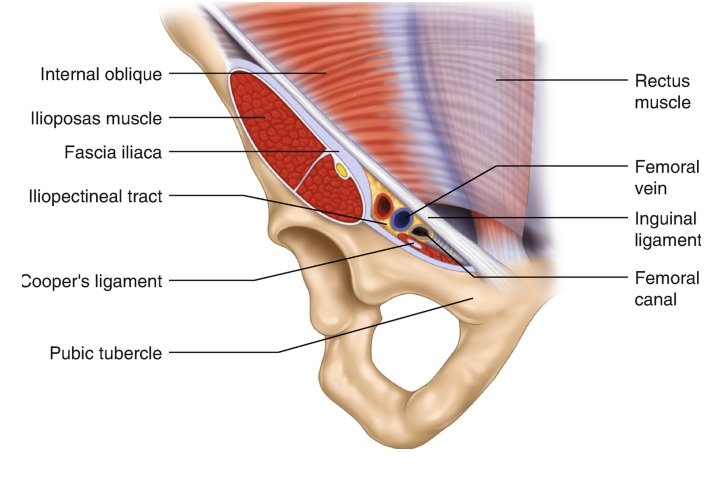Inguinal Region
The inguinal region can be summarized as:
It is located as an oblique inferomedial canal through the inferior anterolateral abdominal wall. It is parallel and superior to the medial region of the inguinal ligament.
Its contents include:
In men:
Spermatic cord (vas deferens, testicular artery and the pampiniform plexus of veins)
In women:
Round ligament of the uterus
It begins at the deep inguinal which is the midinguinal point (midpoint between the anterosuperior iliac spine and the pubic symphysis, lateral to inferior epigastric vessels) and ends at the superficial inguinal ring which is an opening in the aponeurosis of the external oblique muscle superior to the pubic tubercle. Further widening of the ring is prevented by the intercrural fibres.
Notes on the superficial inguinal ring:
Base - pubic crest
Medial crus - pubic crest/symphysis
Lateral crus - pubic tubercle
Notes on the inguinal canal:
Roof - fibres of internal oblique and transversus abdominis muscles
Floor - medial region of the inguinal ligament
Anterior wall - aponeurosis of the external oblique muscle. This is laterally reinforced by the internal oblique muscle
Posterior wall - transversalis fascia. This is reinforced by the conjoint tendon medially and the union of the aponeurosis of the internal oblique and tranversus abdominis muscles
Clinical Notes:
Inguinal hernias as protrusions of parietal peritoneum and visceral from the abdominal cavity. Pain or ischemia may occur in the event that the bowl or fat herniate. To examine:
Patient has to stand while the physician presses down on the superficial inguinal ring and gradually moves the fingers in a lateral direction. This is because when lying in a supine position, the herniation drops back into the abdominal cavity. When moving the fingers laterally, if a lump appears, there might be herniation.
Direct hernia (acquired) can be summarized as:
Leaves through the superficial inguinal ring
Caused by weakness in the anterior abdominal wall muscles in the inguinal triangle (Hesselbach) which lies between the inferior epigastric artery, rectus abdominis, and the inguinal ligament.
Its contents include peritoneum and transversalis fascia
An identifying landmark is that it lies medial to the epigastric vessels and pubic tubercle
Indirect hernia (congenital) can be summarized as:
Leaves through the deep inguinal ring, superficial ring, and commonly enters the scrotum
Caused by patent processus vaginalis
Its contents include peritoneum and all three fascial coverings of the spermatic cord or round ligament
An identifying landmark is that it lies lateral to the inferior epigastric vessels and pubic tubercle

